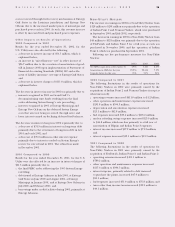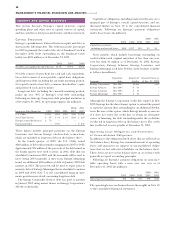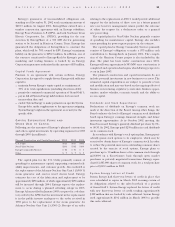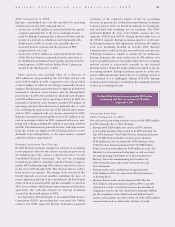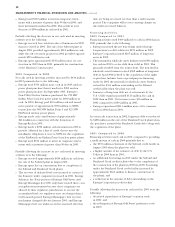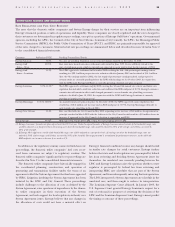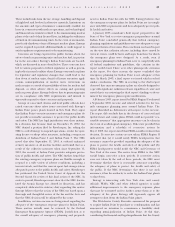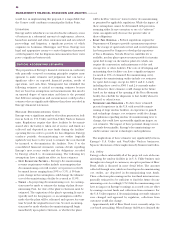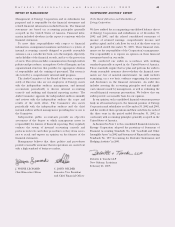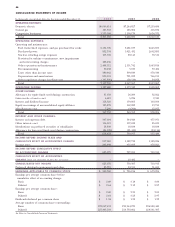Entergy 2002 Annual Report Download - page 36
Download and view the complete annual report
Please find page 36 of the 2002 Entergy annual report below. You can navigate through the pages in the report by either clicking on the pages listed below, or by using the keyword search tool below to find specific information within the annual report.
MARKET AND CREDIT RISKS
Market risk is the risk of changes in the value of commodity and
financial instruments, or in future operating results or cash
flows, in response to changing market conditions. Entergy is
exposed to the following significant market risks:
the commodity price risk associated with Entergy’s Non-
Utility Nuclear and Energy Commodity Services segments;
the foreign currency exchange rate risk associated with
certain of Entergy’s contractual obligations; and
the interest rate and equity price risk associated with
Entergy’s investments in decommissioning trust funds.
Entergy is also exposed to credit risk. Credit risk is the risk of
loss from nonperformance by suppliers, customers, or financial
counterparties to a contract or agreement. Where it is a signifi-
cant consideration, counterparty credit risk is addressed in the
discussions that follow.
Commodity Price Risk
POWER GENERATION
The sale of electricity from the power generation plants owned
by Entergy’s Non-Utility Nuclear business and Energy Com-
modity Services, unless otherwise contracted, is subject to the
fluctuation of market power prices. Entergy’s Non-Utility
Nuclear business has entered into power purchase agreements
(PPAs) and other contracts to sell the power produced by its
power plants at prices established in the PPAs. Entergy continues
to pursue opportunities to extend the existing PPAs and to enter
into new PPAs with other parties. Following is a summary of the
amount of Entergy’s Non-Utility Nuclear business’ and Energy
Commodity Services’ output that is currently sold forward under
physical or financial contracts at fixed prices:
2003 2004 2005 2006 2007
Non-Utility Nuclear:
% of planned generation
sold forward 100% 92% 25% 11% 9%
Planned generation (GWh) 33,317 33,361 34,006 34,613 34,300
Average price per MWh $37.06 $38.36 $35.94 $31.97 $31.42
Energy Commodity Services:
% of planned generation
sold forward 38% 18% 22% 19% 21%
Planned generation (GWh) 3,124 3,249 3,820 3,494 3,618
Contracted spark spread
per MWh $11.70 $10.63 $10.62 $ 9.69 $ 9.68
The Vermont Yankee acquisition included a 10-year PPA
under which the former owners will buy the power produced
by the plant through the expiration of the current operating
license for the plant. The PPA includes an adjustment clause
under which the prices specified in the PPA will be adjusted
downward annually, beginning in 2006, if power market prices
drop below the PPA prices. Accordingly, because the price is
not fixed, the table above does not report power from that
plant as sold forward after 2005.
Under the PPAs with NYPA for the output of power from
Indian Point 3 and FitzPatrick, the Non-Utility Nuclear business
is obligated to produce at an average capacity factor of 85% with
a financial true-up payment to NYPA should NYPA's cost to
purchase power due to an output shortfall be higher than
the PPAs' price. The calculation of any true-up payments is
based on two two--year periods. For the first period, which ran
through November 20, 2002, Indian Point 3 and FitzPatrick
operated at 95% and 97%, respectively, under the true-up
formula. Credits of up to 5% reflecting period one generation
above 85% can be used to offset any output shortfalls in the
second period, which runs through the end of the PPAs on
December 31, 2004.
Entergy continually monitors industry trends in order to
determine whether asset impairments or other losses could
result from a decline in value, or cancellation, of merchant
power projects, and records provisions for impairments and
losses accordingly.
MARKETING AND TRADING
The earnings of Entergy’s Energy Commodity Services segment
are exposed to commodity price market risks primarily through
Entergy’s 50%-owned, unconsolidated investment in Entergy-
Koch. Entergy-Koch Trading uses value-at-risk models as one
measure of the market risk of a loss in fair value for EKT’s
natural gas and power trading portfolio. Actual future gains and
losses in portfolios will differ from those estimated based upon
actual fluctuations in market rates, operating exposures, and
the timing thereof, and changes in the portfolio of derivative
financial instruments during the year.
To manage its portfolio, EKT enters into various derivative
and contractual transactions in accordance with the policy
approved by the trading committee of the governing board of
Entergy-Koch. The trading portfolio consists of physical and
financial natural gas and power as well as other energy and
weather-related contracts. These contracts take many forms,
including futures, forwards, swaps, and options.
Characteristics of EKT’s value-at-risk method and the use of
that method are as follows:
Value-at-risk is used in conjunction with stress testing,
position reporting, and profit and loss reporting in order
to measure and control the risk inherent in the trading
and mark-to-market portfolios.
EKT estimates its value-at-risk using a model based on
J.P. Morgan’s Risk Metrics methodology combined with
a Monte Carlo simulation approach.
EKT estimates its daily value-at-risk for natural gas and
power using a 97.5% confidence level. EKT’s daily value- at-
risk is a measure that indicates that, if prices moved against
the positions, the loss in neutralizing the portfolio would
not be expected to exceed the calculated value-at-risk.
MANAGEMENT’S FINANCIAL DISCUSSION AND ANALYSIS continued
34
Entergy’s Non-Utility Nuclear business has entered
into power purchase agreements and other contracts to sell
the power produced by its power plants at prices
established in the PPAs.



